|
| Pazhani Subramanya
Pillai (1909 - 1962) |
|
Pazhani Subramanya
Pillai learnt the art of mridangam playing from his father Pazhani Muthaiah
Pillai and from Pudukottai Dakshinamoorthi Pillai. Subramanya Pillai's
soft play and pleasing artistry made him shine amongst other stalwarts
like Palghat Mani Iyer who has himself acknowledged Subramanya Pillai as
a great mridangam player
|
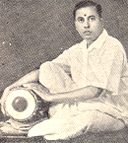 |
Pazhani Subramanya
Pillai who belonged to the Pudukkotai tradition was the star disciple
of Pudukkotai Dakshinamurthy Pillai and it is after his name that
the Pazhani School of playing evolved.He, while retaining the salient
features of the Pudukkotai tradition, introduced many innovative features.He
is credited with presentation of patterns with "ghumkis" (graces).Predominance
of the soft and simple sarvalaghus to sweeten music, their logical development
into astonishing varieties and tirmanas and the clarity of strokes in fast
play formed fascinating traits in his artistry.
|
|
|
A left hand player,
Subramanya Pillai accompanied on either mridangam or kanjira. Subramanya
Pillai was an Asthana Vidwan in Trivandrum Court. He was a professor at
Tamil Isai College and advisor at All India Radio.
|
|
|
|
|
| Palghat Mani Iyer |
|
Born in 1912 of
Smt. Anandambal and Sri Tiruvilvamalai R
Sesha Bhagavatar, a well known musician,
at Pazhayanur, Mani Iyer had his first lessons in Mridangam, when he was
nine years old,from Sathapuram Subbier and later under Viswanatha Iyer.
He made his debut in The Music Academy when he was only 14 years of age.
He came into contact with mridangam vidvan Tanjore Vaidyanatha
Iyer with whom he had further training in the intricacies
of the art. He became closely associated in
numerous performances with Pudukottai Dakshinamurthi Pillai. He received
Sangeetha Kalanidhi for Carnatic Percussion Instrumental in 1956 and was
also invited in 1965 to participate in the Commonwealth Music Festival
in London and in the Edinburgh Festival.
|
 |
The degree of his
instrumental perfection and the genius of his playing with minute attention
to the styles of the main performers made him an artist of unparalleled
calibre in the world of Carnatic music. He gave more importance to pauses
which add laya lustre. He gave a totally new dimension to 'tani avarthanam'
playing in concerts. Mani Iyer held the view that a 'tani avarthanam' is
not such a big affair since the mridangist only repeats the 'korvais' and
'kanakkus' he has thought about and practised at home. Also, according
to him, the mridangam accompanist taking more than 10 minutes in a concert
for his solo turn was no good.
|
|
|
This is in sharp
contrast to the current trend in concerts which witness laya bouts in the
name of 'tani avarthanam' for durations ranging between 20 and 30 minutes,
creating the process a side show.
Mani Iyer felt that a percussionist should also have knowledge
of songs mostly sung in concerts for he had realised that knowledge of
the movement of musical patterns enables a percussionist to play his 'sollus'
with perception and he was himself a good vocalist.
Mani Iyer's playing
on the instrument created the essential understanding even for the uninitiated
through the various melodic sounds of rhythm, and made them sit up and
appreciate. The percussion instrument was put in a high pedestal by Mani
Iyer.
In the area of accompaniment Mani Iyer stands the tallest
for all times. His acute awareness of the singers' or instrumentalists'
micro - second level nuances - his acute sense of the particular situation
or context of a sangathi/sahitya or even a vocal accent, and how he responded
to it with his mridangam play or even very sensible silence - this heralded
a new era of percussion.
The infinite ways of adding colour to a
Kriti, Niraval or Swaraprasthara by changing the Sarvalaghu patterns in
midstream or even the Nadais and the sudden fast forward or reversal of
the Chouka, Madhyama and Duritha or the incomparable use of the left for
emphasis, softness and emotive effects bring forth his greatness. |
|
|
|
| RAMANATHAPURAM
C S MURUGABHOOPATHI |
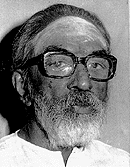
|
Murugabhoopathi was
born to Chitsabhai Serrai of Ramanathapuram. He had his training form his
father and his brother C.S.Sankara Sivam. He was a favourite Mridangist
for the flute maestro T.R. Mahalingam.
Murugabhoopathi has been the visiting Principal for Tamil
Isai Sangam Music school, Madurai and has been a member of the Advisory
Committee Government Music College Madras. He has received numerous titles
including the Kalaimamani, Padmashri and the Sangeet Natak Academy Award. |
|
|
|
|
| UMAYALPURAM K
SIVARAMAN |
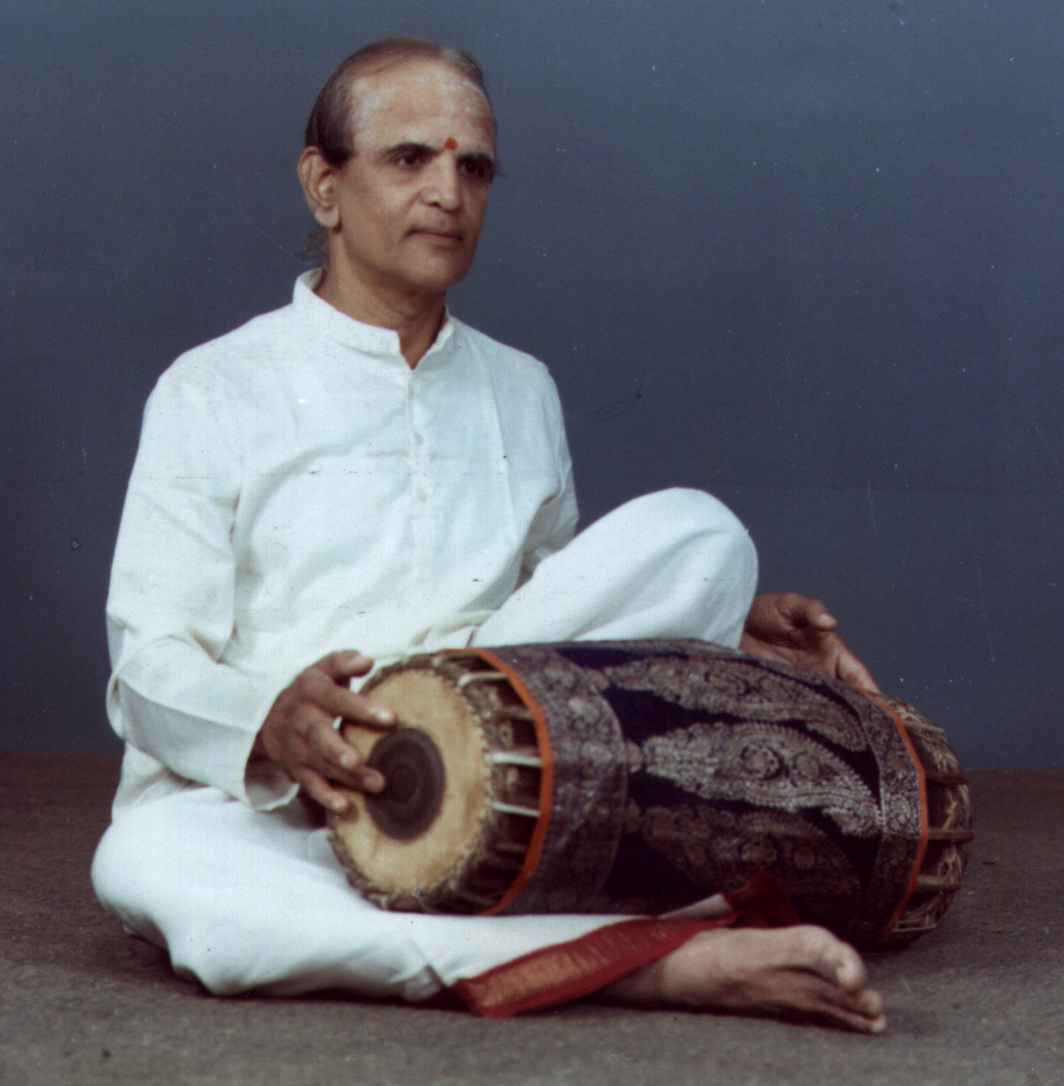 |
Born on 17-12-1935,
he is the son of Dr P. Kasiviswanatha Iyer and Smt Kamalambal. His father,
a medical practitioner and himself an accomplished musician, had with insight
and intuition nurtured the inborn talents of his son and got him rightly
initiated into mridangam through the gurukula discipline under scholarly
practitioners.
Sivaraman learnt this divine art under four great and
illustrious masters : Arupathi Natesa Iyer,
Tanjavoor Vaidyanatha Iyer, Palghat Mani Iyer, Kumbakonam
Rangu Iyengar. The pursuit of this art under the gurukula system for well
over fifteen years did not deter him to qualify for law. He is a double
graduate of The University of Madras (B.A., B.L.).
|
|
|
As a boy of ten,
Sivaraman had his ‘arangetram’ (first concert) and
the debut was held in the precincts of Kalahastheeswaraswami temple in
the temple town of Kumbakonam. Having made his debut at a tender age of
ten, Sivaraman has been in the field as a ‘top notcher’ for
half a century now, accompanying a galaxy of maestros of recent
past and artistes of great merit today, both vocal and instrumental. His
new techniques, innovations and creative ability in accompaniment,
solo renditions, and jugalbandhi; programmes with
his North Indian counterparts have earned him a special place in
the world of art, worthy of emulation by other artists.
Besides his professional career, he had undertaken the
very laudable task of doing original research in the art of mridangam.
This resulted in his highly acclaimed lecture demonstrations done in all
important centres in India and abroad, which enabled him to disseminate
knowledge of this divine art to art lovers, music conferences, music seminars
and the like. He is the only mridangam vidwan who has explored and placed
before the world of art lovers authentic information on the techniques
and nuances of mridangam for more than two decades.
He has introduced the fibre glass mridangam to Carnatic
music for the first time, improvised a mechanical jig to eliminate human
error in the moulding of skins for both sides of the instrument and has
done research work on tanned and untanned skins for the mridangam. His
analysis of the ingredients of the black patch has given much insight on
the overtones produced by different strokes on the mridangam.
|
|
Sivaraman is an ‘A’ Grade artiste in All India Radio
and Doordarshan Television. He has presided over the Annual Music Conference
of the Indian Fine Arts Society, Madras, in 1984 and was conferred the
title of Sangeetha Kala Sikhamani. Sivaraman has been appointed as the
Director for ‘Tanjore Vaidyanatha Iyer School for Percussion’ recently
started by the Music Academy, Madras.
|
|
Several honours and titles were bestowed on
Sivaraman for his great services to this divine art. He was
conferred the award ‘Padmashri’ by the Government of India in 1988.
He received Sangeet Natak Akademi award for mridangam for the year 1992.
His titles include Laya Jyothi, Laya Gnana Bhaskara, Sangeetha Kala Sikhamani,
Mridanga Nadamani (bestowed by His Holiness Shri Sankaracharya
of Kanchi Mutt), Mridanga Chakravarthi, Nada Sudharnava, Tal Vilas,
and Laya Gnana Tilaka to name a few. He has trained many Indian and foreign
students in the art of mridangam and continues training more disciples.
|
|
|
|
|
|
| KARAIKUDI R
MANI |
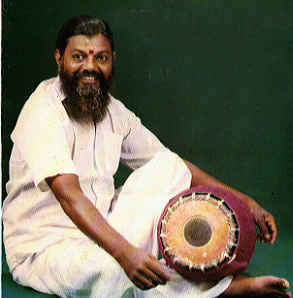
|
Karaikudi R Mani
is India's top ranking player of the mridangam. Mani who had his training
under eminent teachers, has established a unique playing style which is
marked by great virtuosity and pleasing sound quality. Mani, who has been
described as a "mridangist who beautifully blended sound, scholarship,
sense and silence", has composed and launched numerous intricate and erudite
rhythmic combinations which have influenced and won acclaim from music
lovers as well as from other musicians.
|
|
|
The quality of Mani's artistry
has established beyond doubt the capacity of the mridangam to be presented
as the main instrument in solo recitals. Mani has made a distinctive contribution
to the development of the art of percussion through the innovatively novel
percussion ensembles he has devised entitled "Sruthi Laya" with top ranking
artists.
|
|
Mani was also responsible for the formation of the musical
orchestration of cultures called 'Melodyssey' consisting of 40 artists
of South Indian, North Indian and Western instruments along with voices.
This innovative orchestration won widespread appreciation. Mani has also
introduced the Laya Ratna percussion duet concerts which have been performed
in most of the leading forums in India. These concerts promote a greater
understanding of the rythmic aspects of percussion. Mani's objective in
the formation of yet another unique percussion ensemble of young artists,
entitled Tala Vichitra ( Rhythmic peculiarities), has been the integration
of various contemporary styles of South Indian Percussive art form.
|
|
Mani founded the institution Sruthi Laya Seva Trust in
Madras and Mysore in India, and in Melbourne and London to impart systematic
training in Mridangam for advanced students. Many awards, titles and honours
came to him which he shunned for developing his art with greater devotion.
|
|
|
|
|
|
|
| GURUVAYUR DORAI |
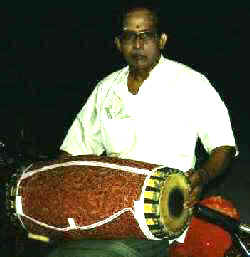 |
Born on 2nd July,
1935 Guruvayur Dorai started to play mridangam at a very young age.His
gurus were the Palghat Subba Iyer and Pazhani Subramanya Pillai. His 'Arangetram'
(first concert ) was held at the Srikrishna Temple at Guruvayur at the
age of 8 when he played for the renowned Chembai Vaidyanatha Bhagavathar.
In 1954, he got a rare oppurtunity to accompany the legendary Nadaswaram
artist T N Rajarathinam Pillai. Since then Dorai has accompanied almost
all famous carnatic musicians in in an illustrious carrier that has spanned
five decades.
|
|
|
Dorai has taught mridangam at
several music schools. He was a visiting Professor at the University of
Washington, Seattle between 1977 - 1978. In 1979, he taught at the Sydney
University, australia in conjunction with Professor T N Krishnan. Dorai
is currently the Dean of temple of Fine Arts, an International organisation
for the promotion of Fine Arts and Dance in Kuala Lumpur.
|
|
|
|
|
|
|